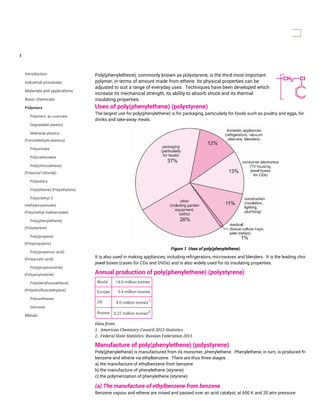
Poly(phenylethene) (polystyrene)
- 1. Poly(phenylethene), commonly known as polystyrene, is the third most important polymer, in terms of amount made from ethene. Its physical properties can be adjusted to suit a range of everyday uses. Techniques have been developed which increase its mechanical strength, its ability to absorb shock and its thermal insulating properties. Polymers Poly(phenylethene) (Polystyrene) Poly(phenylethene) (Polystyrene) Uses of poly(phenylethene) (polystyrene) The largest use for poly(phenylethene) is for packaging, particularly for foods such as poultry and eggs, for cold drinks and take-away meals. Figure 1 Uses of poly(phenylethene). It is also used in making appliances, including refrigerators, microwaves and blenders. It is the leading choice for jewel boxes (cases for CDs and DVDs) and is also widely used for its insulating properties. Annual production of poly(phenylethene) (polystyrene) World 14.6 million tonnes Europe 3.4 million tonnes US 4.0 million tonnes1 Russia 0.27 million tonnes2 Data from: 1. American Chemistry Council 2013 Statistics 2. Federal State Statistics: Russian Federation 2011 Manufacture of poly(phenylethene) (polystyrene) Poly(phenylethene) is manufactured from its monomer, phenylethene. Phenylethene, in turn, is produced from benzene and ethene via ethylbenzene. There are thus three stages: a) the manufacture of ethylbenzene from benzene b) the manufacture of phenylethene (styrene) c) the polymerization of phenylethene (styrene) (a) The manufacture of ethylbenzene from benzene Benzene vapour and ethene are mixed and passed over an acid catalyst, at 650 K and 20 atm pressure: CONTENTS Home Introduction Industrial processes Materials and applications Basic chemicals Polymers Polymers: an overview Degradable plastics Methanal plastics (Formaldehyde plastics) Polyamides Polycarbonates Poly(chloroethene) (Polyvinyl chloride) Polyesters Poly(ethene) (Polyethylene) Poly(methyl 2- methylpropenoate) (Polymethyl methacrylate) Poly(phenylethene) (Polystyrene) Poly(propene) (Polypropylene) Poly(propenoic acid) (Polyacrylic acid) Poly(propenonitrile) (Polyacrylonitrile) Poly(tetrafluoroethene) (Polytetrafluoroethylene) Polyurethanes Silicones Metals search...
- 2. Figure 2 This Triumph motorcycle has a fairing (the structure around the bike that reduces drag by streamlining) made of a blend of ABS and a polyamide. It is light, very strong and has a high chemical and heat This is an example of a Friedel-Crafts reaction. The acid catalyst now used is a zeolite, ZSM-5, an aluminosilicate. (b) The manufacture of phenylethene (styrene) Ethylbenzene vapour is mixed with excess steam and passed over heated iron(lll) oxide. Other metal oxides used as the catalyst including those of magnesium, chromium(III) and zinc, usually coated on carbon or alumina. It is dehydrogenated: A small amount of potassium oxide is mixed with the iron(lll) oxide (which keeps the catalyst in the iron(lll) state). The steam reduces 'coking' (the formation of soot on the catalyst from the decomposition of ethylbenzene at the high temperatures used). (c) The polymerization of phenylethene (styrene) Radical polymerization is used to produce the polymer. The process is an example of addition polymerization The predominant polymerization technique is continual thermal mass polymerization which is initiated by heat alone. Suspension polymerization is also used. This technique requires the use of an initiator such as dibenzoyl peroxide. Poly(phenylethene) is a clear thermoplastic, with good moisture resistance, but is rather brittle. A tougher product is also manufactured by polymerizing phenylethene containing 5-10% dissolved poly(buta-1,3-diene) rubber. This tougher product - generally knownas High Impact Polystyrene (HIPS) - is made exclusively by continuous thermal mass polymerization, in which heat is required to initiate the polymerization reaction. This toughened polymer is translucent. The structure of poly(phenylethene) made by these technologies is completely random in structure and is known as an atactic structure. By modification of the polymerization technique - principally by the use of metallocene catalysts - stereoregular (syndiotactic) structures can be obtained. This syndiotactic polymer (sPS) has improved properties - particularly thermal and mechanical. Another co-polymer is formed on polymerizing a mixture of phenylethene (styrene) and propenonitrile (acrylonitrile). It is known as SAN (styrene-acrylonitrile). It is less flexible, more transparent and has more resistance to heat and chemicals than poly(phenylethene). It is used in car headlamps, cassette covers, syringes and high quality kitchen appliances. A further modification involves the co-polymerization of phenylethene (styrene) with propenonitrile (acrylonitrile) in the presence of poly(buta-1,3-diene) to make ABS plastics. A, B, S represent acrylonitrile, butadiene and styrene, which give strength (A), flexibility (B), and hardness (S). Typically this plastic has a composition: 60% (w/w) phenylethene (styrene), 25% propenonitrile (acrylonitrile), 15% buta-1,3-diene. The initiator used is often potassium peroxydisulfate, K2S2O8.
- 3. resistance, which means the fairing can be installed near the engine and the exhaust pipe. By kind permission of BASF. Figure 3 These poly(phenylethene) beads are shown prior to and after expansion. They were impregnated during manufacture with very fine particles of graphite to improve further their ability to absorb heat. By kind permission of BASF. ABS is tougher, scratch proof and more chemically resistant than rubber-modified poly(phenylethene) and is used, for example, in casings for computers, cycle helmets, calculators, telephones, vacuum cleaners and toys. Often ABS is blended with SAN to make it even more rigid. Another variation is the co-polymer formed between ABS and methyl 2-methylpropenoate, which has a high resistance to chemical attack, high transparency and is very tough. Expanded poly(phenylethene) (polystyrene) Expanded poly(phenylethene) is manufactured as beads containing pentane (a liquid at room temperature). When they are heated in steam, the hydrocarbon volatilises and the beads expand (Figure 3). These are subsequently blown into moulds and fused by further steaming and then cooling. The expanded poly(phenylethene) has good thermal insulation and shock absorbing properties.
- 4. Date last amended: 2nd January 2014 Copyright © 2014 CIEC Promoting Science at the University of York, York, UK. All Rights Reserved. Joomla! is Free Software released under the GNU/GPL License.
